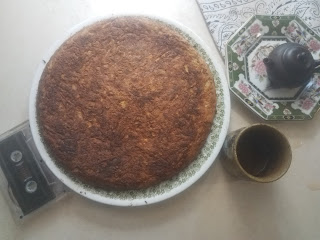daikon kugel recipe- luo bo gao
recently, i have been experimenting with making some non-traditional kugels. i didn’t grow up eating many kugels (some, but not many) and i haven’t made any until recently. they’ve been great to add into my weird diet that tries not to eat too many grains, is gf, dairy free, and legume free. it’s nice to make a big ol’ kugel and have it to easily heat up and add to my meals throughout the week when i don’t have as much time or energy to cook.
this recipe i made up takes inspiration from one of my favorite dim dum dishes (which is the reason i feel it is reasonable to post on this tea blog). i love those crispy on the outside and gooey on the inside daikon cakes served with many dim sum meals. the real daikon cake, Luo Bo Gao, is a lil too complicated for my daily meal prep, so i made this rip-off kugel version that’s a lot quicker.
*i don’t measure when i cook, so these measurements are approximations, but i think it’s still pretty spot on
ingredients:
-one large russet potato (1.5C grated)
-2 medium size daikon radishes (1.5C grated)
-3 eggs
-1 cup gf or wheat flour
-1/2 teaspoon baking soda
-table spoon sambal olek (or less depending on how much heat you like)
-1 tablespoon of lacto-fermented diced chilis
-diced large clove garlic
-1 tablespoon sugar (optional)
-2 teaspoons coarse salt
-1/2 cup sf oil (or mild oil that takes heat well)
-scallions to garnish
-salt
-------
preheat oven to 375F and place 10 inch cast iron skillet in oven to heat up.
grate potato and daikon into bowl. add all other ingredients (minus ¼ cup of the oil) and mix together. carefully take hot pan out of oven. pour remaining ¼ cup of oil in pan and make sure it covers all surfaces. add kugel mixture into pan and spread from edge to edge evenly. bake for 35-40 minutes. remove pan and SAFELY place plate over top of pan, hold tightly, use potholders, and flip kugel onto a plate. should come out easily. top with thinly cut scallions. serve with dim shalom (joke about prayer called ‘SIM shalom’ and DIM sum)

Comments
Post a Comment